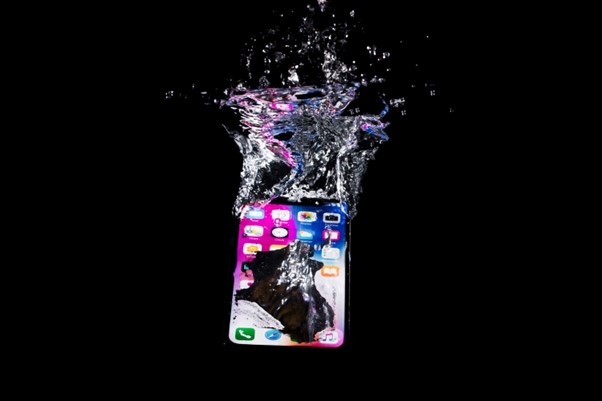Dropped your iPhone in the toilet? Splashed it with a margarita? Don’t panic—yet. A wet iPhone doesn’t always mean a dead one. We’ll guide you through saving your precious tech, from the first panicked moments to a (hopefully) fully functioning phone.
In this guide, we’ll cover:
- Immediate steps to take after your phone takes a dive
- The do’s and don’ts of drying your device
- Troubleshooting tips to revive your iPhone
- When it’s time to call in the professionals
Even if your screen is already flickering, don’t give up hope. We’ve got your back (and your iPhone).
iPhone Underwater? Act Fast to Minimize the Damage
The moment your iPhone goes for an unexpected swim, every second counts. Whether it’s a quick dip or a full-on dunk, acting fast can mean the difference between a minor inconvenience and a major tech tragedy. So, take a deep breath (not your iPhone, though) and follow these crucial first steps:
- Retrieve it, stat. Don’t let your phone marinate in water any longer than necessary. The sooner you get it out, the less liquid it will absorb.
- Power off. If your phone isn’t already off, resist the urge to check for damage. Turn it off immediately to prevent electrical shorts and further damage.
- Skip the rice. Contrary to popular belief, rice isn’t your phone’s savior. It won’t do much to absorb moisture and might even introduce debris into the charging port.
- Remove accessories. Take off any cases, screen protectors, or other attachments. This helps with airflow and prevents water from getting trapped.
- Gently wipe it down. Use a soft, absorbent cloth (microfiber is ideal) to remove any visible water from the exterior of your phone. Avoid shaking or tapping, as this could push water further inside.
Pro tip: If you have a SIM card removal tool handy, eject the SIM card tray and gently dry it off before reinserting.
These initial actions might seem simple, but they’re crucial in minimizing damage and increasing your chances of a successful iPhone resuscitation.
Dry It Out: Patience is Key (And Knowing What Not To Do)
Alright, you’ve retrieved your soggy iPhone and powered it down. Now comes the waiting game – the drying phase. This is where you can make or break your phone’s chances of survival. So, let’s dive into the dos and don’ts of drying your device:
DO:
- Let it air dry. Find a cool, dry place with good airflow (like a countertop or shelf) and lay your phone flat on a soft cloth. Let it air dry naturally for at least 24-48 hours.
- Use silica gel packets. Remember those little packets that come in shoeboxes and electronics packaging? They’re filled with silica gel, a desiccant that absorbs moisture. Grab a bunch of them (or buy some online) and bury your phone in a sealed container with them.
- Consider a dehumidifier. If you have a dehumidifier, placing your phone nearby (but not directly on top of it) can help speed up the drying process.
DON’T:
- Use heat. Resist the urge to use a hairdryer, oven, microwave, or any other heat source. Heat can damage your phone’s internal components and make matters worse.
- Plug it in. Don’t even think about charging your phone until it’s completely dry. Water and electricity are a dangerous combination that could lead to a fried circuit board.
- Shake or tap it. We know it’s tempting, but avoid shaking or tapping your phone to remove water. This could push it further into sensitive areas.
Patience, young grasshopper.
Remember, drying your iPhone takes time. Be patient and resist the urge to turn it on prematurely. The longer you wait, the better the chances of a full recovery. We’re not saying you have to wait 48 hours to find out if your phone is okay, but it’s the safest route to go.
Pro tip: If you have a fan, you can gently blow cool air over your phone to help with the drying process. Just be sure to keep it at a safe distance and avoid using a high-speed setting.
Lights Out? Don’t Despair, Try These Troubleshooting Tips
After your iPhone has had ample time to dry out (remember, patience is key), it’s time for the moment of truth: powering it back on. Here’s what to do if your phone doesn’t spring back to life immediately:
- Charge it up. Before hitting the power button, plug your iPhone into its charger and let it charge for at least an hour. Even if it doesn’t seem to be charging, give it time. Sometimes, a wet battery needs a little coaxing.
- Try a hard reset. If charging doesn’t do the trick, try a hard reset. This varies depending on your iPhone model, but typically involves pressing a combination of buttons (check Apple’s support website for instructions).
- Look for signs of life. Even if your phone won’t turn on completely, keep an eye out for any signs of activity. Does it vibrate when plugged in? Does the Apple logo appear briefly? These could indicate that your phone is partially functional and may just need a little more time or professional attention.
If It Still Won’t Turn On:
- Check the charging port. Inspect the charging port for any debris or corrosion. If you see any, carefully clean it out with a soft-bristled brush (like a toothbrush) and try charging again.
- Connect to iTunes. If you have a computer with iTunes, try connecting your iPhone. iTunes might recognize it and offer options for recovery or restoration.
- Visit an Apple Store. If all else fails, it’s time to consult the experts. Take your iPhone to an Apple Store or authorized repair center for diagnosis and repair.
Don’t Give Up Hope
Remember, even if your iPhone seems completely unresponsive, there’s still a chance it can be saved. With patience, persistence, and a little luck, you might just resurrect your beloved device. And if not, well, at least you tried everything you could.
DIY Not Cutting It? Know When to Call in the Pros
You’ve meticulously followed our guide, but your iPhone is still as silent as a fish. Don’t beat yourself up – sometimes, water damage requires a professional touch. Here’s when it’s time to wave the white flag and seek expert help:
- Visible Damage: If you see any signs of corrosion, discoloration, or warping on your phone’s exterior or within the charging port, it’s a red flag for internal damage.
- Persistent Issues: If your phone turns on but experiences issues like distorted sound, a glitchy screen, or unresponsive buttons, it’s likely there’s lingering water damage affecting the hardware.
- No Signs of Life: If your iPhone remains completely unresponsive after thorough drying and troubleshooting attempts, professional diagnosis and repair are your best bet.
Where to Turn?
- Apple Store or Authorized Repair Center: This is your safest option, as they use genuine Apple parts and certified technicians. However, repairs can be pricey and may not be covered by your warranty if water damage is detected.
- Third-Party Repair Shops: Many reputable independent shops offer iPhone repairs at a lower cost than Apple. Be sure to research their reputation and inquire about warranties before handing over your device.
- DIY Repair Kits: If you’re feeling adventurous and tech-savvy, you can purchase DIY repair kits online. However, this is only recommended for those with experience in electronics repair, as you risk causing further damage if done incorrectly.
Pro Tip: Before taking your iPhone in for repair, back up any important data to iCloud or your computer (if possible). This ensures that your photos, contacts, and other essential information are safe, even if your phone needs a complete wipe.
Don’t let a little water ruin your day (or your iPhone). With quick action, proper drying techniques, and professional help when needed, your phone might just make a full recovery. After all, it’s not just a phone – it’s your lifeline to the digital world.
Need a Helping Hand? We’re Here to Rescue Your Tech
By following these steps, you’ve given your phone the best chance of surviving its unexpected dip. Remember, patience and quick action are key when it comes to water damage.
Key takeaways:
- Act fast: Retrieve your phone and power it off immediately.
- Don’t use rice: Opt for silica gel packets or a dehumidifier instead.
- Air dry: Let your phone dry out naturally for at least 24-48 hours.
- Troubleshoot: Try charging, hard reset, and check for signs of life.
- Call in the pros: If DIY methods fail, seek professional help.
If your iPhone is still giving you the cold shoulder (or screen), don’t fret! Our team of tech experts is here to help. We specialize in iPhone water damage repair and can diagnose and fix any lingering issues.
Reach out to us today for a free consultation, and let us bring your iPhone back to life.




Write a Comment